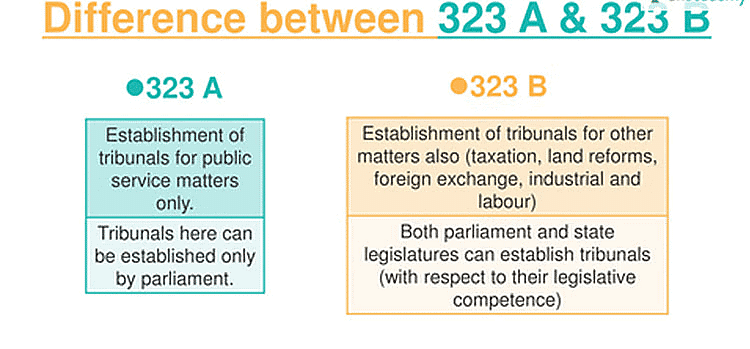Laxmikanth Summary: Tribunals | Indian Polity for UPSC CSE PDF Download
| Table of contents |

|
| Administrative Tribunals |

|
| Central Administrative Tribunal (CAT) |

|
| State Administrative Tribunals |

|
| Tribunals for Other Matters |

|
A tribunal is like a special court that handles different kinds of problems, such as sorting out arguments about taxes or administrative issues. It does a bunch of things, like making decisions about disputes, figuring out who's right in a disagreement, or giving a verdict on administrative matters. In the beginning, our Constitution didn't talk about tribunals, but later on, the 42nd Amendment Act in 1976 added a section all about them. It's called Part XIV-A, and it has two main parts: Article 323A for administrative tribunals and Article 323B for other kinds of tribunals. The word "tribunal" comes from "tribunes," which were officials in ancient Rome who looked out for the common people against unfair actions by the rich and powerful.
So, a tribunal is basically any person or group that has the power to settle arguments or decide on issues, whether they're officially called a tribunal or not.
 Tribunals
Tribunals
Administrative Tribunals
1. Introduction:- Article 323A is a provision in the Constitution that gives Parliament the authority to create administrative tribunals.
- These tribunals are specifically designed to handle disputes related to the recruitment and conditions of service of individuals employed in various public services.
2. Purpose and Coverage:
- The main purpose of Article 323A is to centralize the resolution of disputes concerning public service employment and conditions.
- It covers disputes that arise within a wide range of public services, including those at the Central government, state governments, local bodies, public corporations, and other public authorities.
- By consolidating these disputes under administrative tribunals, the goal is to ensure that they are addressed promptly and efficiently by experts in the field.
3. Effect on Judicial System:
- Article 323A has a significant impact on the traditional judicial system by transferring the adjudication of service matters from civil courts and high courts to administrative tribunals.
- This shift helps alleviate the burden on the regular judicial system, which often faces delays due to backlog and complexity of cases.
- Administrative tribunals are better equipped to handle service-related disputes, as they have specialized knowledge and expertise in this area.
4. Legislative Action:
- In line with Article 323A, Parliament passed the Administrative Tribunals Act in 1985 to provide a legal framework for the establishment of administrative tribunals.
- This act grants the Central government the authority to establish a Central Administrative Tribunal (CAT), while also empowering state governments to set up their respective State Administrative Tribunals (SATs).
5. Impact on Justice Delivery:
- The establishment of administrative tribunals marks a significant milestone in the justice delivery system, particularly concerning public service disputes.
- By providing a specialized forum for adjudication, these tribunals aim to offer expeditious and cost-effective resolution of grievances faced by public servants.
- This shift towards administrative tribunals underscores a commitment to ensuring prompt and accessible justice for individuals employed in public services.
In summary, Article 323A facilitates the creation of administrative tribunals, which play a crucial role in resolving disputes within public services. This provision not only streamlines the adjudication process but also enhances access to specialized justice for public servants.
Central Administrative Tribunal (CAT)
Central Administrative Tribunal
- The Central Administrative Tribunal (CAT) was established in 1985 with its principal bench located in New Delhi and additional benches in various states.
- It has 19 regular benches, with 17 operating at the principal seats of high courts and two at Jaipur and Lucknow, which also conduct circuit sittings at other high court seats.
- CAT deals with recruitment and service matters of public servants falling under its jurisdiction.
- CAT has original jurisdiction over recruitment and service matters of public servants within its scope.
- Its jurisdiction extends to All-India Services, Central civil services, civil posts under the Centre, and civilian employees of defense services.
- However, it doesn't cover members of the defense forces, Supreme Court officers and staff, and Parliament secretarial staff.
- CAT is a multi-member body comprising a Chairman and Members.
- Originally included a Chairman, Vice-Chairman, and Members, but the provision for Vice-Chairman was removed in 2006.
- Presently, the sanctioned strength includes one Chairman and 69 Members.
- Members are drawn from both judicial and administrative streams, but those below 50 years aren't eligible for appointment.
- Term of office: four years or until the age of 70 for Chairman, and until 67 for Members, whichever is earlier.
- Appointed by the central government based on recommendations from a search-cum-selection committee chaired by the Chief Justice of India or a nominated Supreme Court Judge.
Legal Framework:
- CAT isn't bound by the Civil Procedure Code of 1908 but operates under principles of natural justice.
- Allows flexibility in approach and only requires a nominal fee of ₹50 from applicants.
- Applicants can represent themselves or be represented by a lawyer.
Judicial Review:
- Originally, appeals against CAT orders could only be made in the Supreme Court, not in high courts.
- The Supreme Court, in the Chandra Kumar case (1997), declared this restriction unconstitutional.
- Now, appeals against CAT orders are directed to the division bench of the concerned high court before approaching the Supreme Court.
State Administrative Tribunals
Introduction:- The Administrative Tribunals Act of 1985 empowers the Central government to establish State Administrative Tribunals (SATs) upon specific requests from state governments.
- SATs, like the Central Administrative Tribunal (CAT), have original jurisdiction over recruitment and service matters of state government employees.
Establishment and Jurisdiction:
- SATs are established by the Central government upon request from concerned state governments.
- They exercise original jurisdiction over recruitment and service matters of state government employees, similar to CAT.
Composition and Appointment:
- The Chairman and Members of SATs are appointed by the Central government.
- Appointments are made based on recommendations from a search-cum-selection committee chaired by the Chief Justice of the High Court of the respective state.
Joint Administrative Tribunals (JATs):
- The Administrative Tribunals Act also provides for the establishment of Joint Administrative Tribunals (JATs).
- JATs are set up for two or more states.
- They exercise all the jurisdiction and powers exercisable by administrative tribunals for the states involved.
Legal Framework:
- The provisions regarding SATs and JATs are governed by the Administrative Tribunals Act of 1985.
Similarities with CAT:
- SATs operate similarly to CAT in terms of jurisdiction and composition.
- Both are bodies established to handle recruitment and service matters, with jurisdiction granted by the Central government.
Tribunals for Other Matters
Articles 323A and 323B of the Constitution authorize the establishment of tribunals for adjudicating disputes on specific matters.
They empower both Parliament and state legislatures to create tribunals for various subject areas, providing an alternative dispute resolution mechanism.
 Matters Covered:
Matters Covered:
- Article 323B enumerates specific matters for which tribunals can be established, including taxation, industrial and labor disputes, land reforms, elections, etc.
- In contrast, Article 323A focuses solely on public service matters for tribunal adjudication.
Establishment Authority:
- Tribunals under Article 323A can only be established by Parliament.
- Tribunals under Article 323B can be established by both Parliament and state legislatures, depending on the subject matter falling within their legislative competence.
Tribunal Structure:
- Under Article 323A, only one tribunal for the Centre and one for each state or multiple states can be established.
- There's no hierarchy among these tribunals.
- In contrast, Article 323B allows for the creation of a hierarchy of tribunals.
Judicial Review:
- Initially, provisions of Articles 323A and 323B excluded the jurisdiction of high courts and the Supreme Court.
- The Supreme Court, in the Chandra Kumar case (1997), declared these provisions unconstitutional.
- This decision enabled judicial remedies against tribunal orders, making high courts and the Supreme Court avenues for appeal.
Significance:
- Articles 323A and 323B aim to provide specialized forums for resolving disputes efficiently.
- They grant legislative bodies the authority to establish tribunals tailored to specific subject areas within their jurisdiction.
Overall, these provisions represent an attempt to streamline the adjudication process and ensure access to justice in diverse areas of law.
|
147 videos|609 docs|204 tests
|
FAQs on Laxmikanth Summary: Tribunals - Indian Polity for UPSC CSE
| 1. What is the Central Administrative Tribunal (CAT)? |  |
| 2. What is the function of State Administrative Tribunals? |  |
| 3. How are administrative tribunals different from regular courts? |  |
| 4. What types of matters do administrative tribunals handle? |  |
| 5. Can decisions of administrative tribunals be challenged in regular courts? |  |

|
Explore Courses for UPSC exam
|

|


















